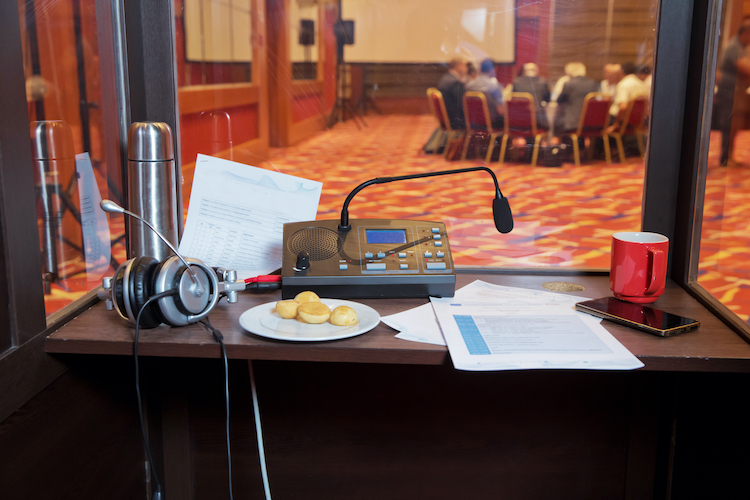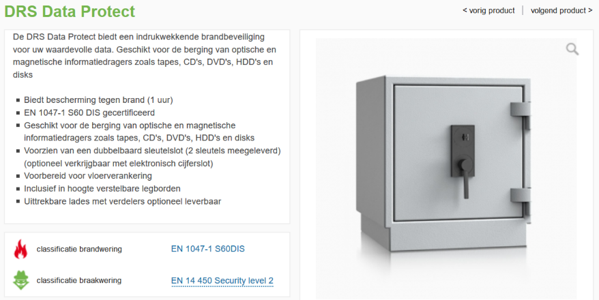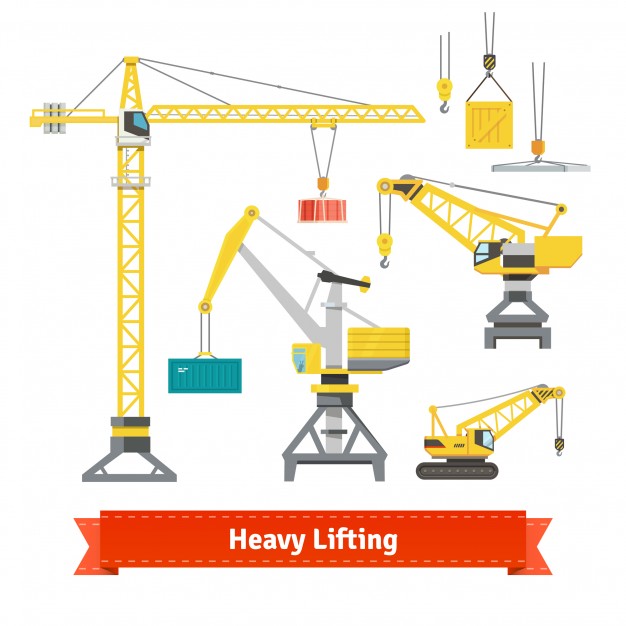Interpreting in times of coronavirus
Written by Ammerins Moss-de Boer
When work dried up
As a result of the Covid-19 outbreak, the world came to a standstill: businesses closed, events were cancelled and appointments postponed. And consequently, for many interpreters, the diary was wiped clean. Because what work is there to do if there are no court hearings, no conferences and no driving tests and weddings? For me as a translator/interpreter, as for many of my colleagues, the effect was instantaneous. The phone stayed silent. The tumbleweed in my inbox was almost audible.
I was fortunate enough to have enough translation work to keep me going, but even on that front it was distinctly slower than before, and the type of work also changed. Most of the texts I translated in the first few weeks (and months) of lockdown were internal notices for employees about Covid-19 prevention measures, new rules about working from home, how to install Zoom, the do’s and don’ts of online meetings etc. I am so glad I have a large enough number of direct corporate customers and agencies to work for instead of being 100% reliant on the public service work!
A technological learning curve
After a few weeks of empty diaries and with despair starting to set in (‘How long IS this going to last?’), interpreters basically had two options: either sit back and wait it out – and apply for the TOGS/TOZO or whatever other arrangements they were eligible for – or explore methods to continue working and embrace new technologies. Slowly but surely, the business world started to wake up again and discovered that you could conduct meetings online just fine. And that was our way in! Where it had been a bit of a niche market before, now suddenly remote simultaneous interpreting (RSI for short) was everywhere! Experienced interpreters are now also sharing their knowledge about RSI by giving webinars and facilitating online interpreting sessions, which is not only educational but also great fun.
The technology that had been available before is now being further developed at lightning speed: there are stand-alone interpreting platforms (eg, VoiceBoxer) or platforms that can be incorporated into meeting software such as Zoom (which has its own interpretation option too). This means that tech-savvy commercial interpreters have been able to get back on the horse. Many companies are also now realizing that it saves a lot of time – including travel time. And, if the technical requirements are met, they are seeing the benefits of having a meeting online where foreign participants can follow what is being said by tuning into their own language channel.
So far, so good!
Commercial versus PSI
On the public service interpreting (PSI) front, courts and government institutions have also been doing their best to incorporate RSI into their way of working. However, as with most public service institutions (… can I say it? ambtenaren…) it has taken a while to get it all up and running. Picture if you can a judge in one room and a clerk in another; plus a prosecutor, a lawyer, and a suspect or inmate in an echoey interrogation room (often with guards impatiently looking at their watches). Getting these people all talking to each other in a structured manner turns out to be quite a feat – not to mention the ‘complication’ of having an interpreter ‘sitting in the middle’. Interpreting these sessions is very frustrating as, more often than not, the video or phone connection is so terrible that interpreting is close to impossible. It also takes longer, as everything has to be done consecutively… And if you then also have a judge who asks the interpreter to ‘summarize your interpretation, because we are in a hurry’ or who denies a suspect their last word because their 20 or 40 minutes is nearly up, you can see why lots of interpreters and lawyers are quite unhappy with the situation.
Back to normal?
When physical sessions resumed a few weeks ago, we all had to get used to the ‘new normal’. How do you maintain physical distance while also making yourself heard and hearing what your client is saying? Is simultaneous interpreting even possible anymore? Every assignment throws up new surprises and challenges, as the set-up is different in every court and interview room. Sometimes half of the parties are physically present, while the rest are on a screen or on the phone – again complicating matters… Luckily, as interpreters, we are masters of improvisation, and most hearings have been able to continue, albeit with a bit of fudging here and there. Some courts have purchased mobile phones, so you can call the suspect sitting on the other side of the plexiglass and interpret the hearing that way. The courts are also still in the middle of the tendering process for whisper systems, so who knows what swanky gear we will be working with in the future!
The immediate future will undoubtedly remain messy, also because the situation for sworn interpreters and translators is not about to improve with the introduction of a new Dutch governmental decree on costs, quality and outsourcing, but I hope that as interpreters we will also continue to learn, to improve our technological expertise and also to educate our clients on how to incorporate new technology.

Having an online UniSIG meeting was a new venture, but on 17 July, 17 punters logged in for an hour-long afternoon session to catch up with each other and discuss the Covid crisis and how it has been impacting our work and lives. Members who’d been following reports in the Dutch and international press mentioned some of the trends in universities’ teaching and student admissions. At least one person had noticed a decline in assignments relating to research grant applications, but it seems that this might simply be because deadlines have been moved back and so grants are still being written.
A few of the teachers of academic and scientific writing had plenty to say about how they’ve had to move their teaching online, so that at times the meeting seemed to be more SENSE Ed than UniSIG. Nevertheless, this only underlines the overlap in interest between the two SIGs – which could be exploited in the future by holding joint SENSE Ed/UniSIG meetings.
As five of the attendees were newbies who’d joined SENSE in 2020, we spent time finding out where they are based and what they do. One of them, Danielle Carter, promoted the new Starters SIG, which she’s helped set up. Mike Gould pointed out that SENSE’s mentoring programme is a good resource for starters in the language profession. It can also be useful for established language professionals who want to acquire a new skill: one of our longstanding UniSIG members is hoping to be mentored so that she can branch out into copywriting.
Our discussion about the format and content of future online meetings yielded various points:
- The ‘as you like it’ style of meeting that kicked off the past two academic years is a nice idea, but if we continue to use a one-hour Zoom format and topics are known beforehand, there should be time limits on the contributors and time should be reserved for spontaneous topics.
- Webinars are not a popular way of holding a meeting.
- We should try breakout groups split along ‘hard’ versus ‘soft’ sciences.
- We should think about what is meant by ‘science’: Ed Hull has promised to talk briefly on this at a future meeting, to kick off a discussion.
- Occasional ‘social’ online meetings would be fun. Late August would be a good time to have one.
I’ll act on these ideas: watch out for UniSIG announcements! And if you have any tips about colleagues or acquaintances who – like Ed – would be prepared to give a short talk (15 minutes) on a topic relating to working for or in academia, please pass them on to me, so I can organize one-hour themed Zoom meetings.
![]()
In this new blog series, we will highlight the different Special Interest Groups (SIGs) SENSE has to offer. SIG meetings are open to all members, and guests are welcome to attend one or two meetings before deciding whether they would like to join SENSE. For upcoming SIG meetings, check the SENSE Events calendar. Contact the SIG convener for more information or to suggest a meeting topic. If you would like to start a new SIG, contact our SIG and Social Events Coordinator. In this edition, we talk to Copywriting SIG co-conveners Stephen Johnston and Martine Croll.
Can you tell me a little about yourself?
SJ: I grew up in Canada, but moved to the Netherlands in 1997 for love. I joined SENSE in 1999, and it has been one of the best decisions of my life. I wear two hats: I’m a copywriter, mostly working for larger international companies, but I’m also a business trainer. I specialize in consultancies, where I help them write more effectively, present more effectively and create client presentations with impact.
MC: My origins are Dutch, but as a child of expat parents, I had an English education. After school, I decided to go to Leiden University and discover my Dutch roots. Fulfilling my childhood dream to become a writer, I set up business as a copywriter. To be perfectly honest, I started off as a translator – I had cold feet, and no real writing experience. I soon found out that badly written texts are a nightmare to translate, so I often found myself asking the client if I could do a rewrite before getting stuck in the translation. My copywriting business took off from there! Nowadays, besides writing, I help companies find their tone of voice and develop their storyline.
I joined SENSE in the late nineties. After being one of those ‘in the woodwork’ members for several years, I volunteered for the EC. A great and worthwhile experience, where I got to think up and organize loads of fun events. Later on, I joined a wonderful team of fellow members to organize the first-ever SENSE jubilee conference.
What is the Copywriting SIG and who is it for?
SJ: The Copywriting SIG is for anybody and everybody with any interest in copywriting. We get a lot of translators and editors who would like to be copywriters. We also get people who are nervous about copywriting, and want to find out more. And, of course, we get seasoned copywriters who bring a wealth of expertise to our group.
MC: Nothing much to add here! Except that our purpose, above all, is to inspire and get inspired by fellow SENSE members. After all, working as English copywriters for Dutch companies, the issues we deal with are very similar to those our fellow editors and translators face. Our open-discussion meet-ups are perfect for learning from each other.
How did the Copywriting SIG get started?
SJ: Many years ago, I noticed there were special interest groups for translators, editors and regions. But there were none for copywriters like myself, so I thought I would organize a one-off meeting to bring all of us copywriters together. In between my post and the meeting, somebody at SENSE suggested that I make it a SIG (which I did). The first meeting was above the American Book Center in Amsterdam. Since then, we’ve moved around a lot – most recently, of course, we meet on Zoom.
I stepped back for a bit a while ago and Martine took over. She was the driving force for many years, and now we are co-conveners.
MC: I’m extremely grateful to Steve for having the brilliant idea to organise something for copywriters. We were (and still are) a minority group within SENSE, so it’s nice to meet up and talk shop every now and then. But, having said that (and at risk of repeating myself), it’s really worthwhile and inspiring to also have non-copywriters or aspiring ones attend and pitch in.
How often does the Copywriting SIG meet up?
SJ: We try to meet up twice a year.
MC: We do indeed aim to do so! But both of us are pretty busy with our own freelance business activities. So sometimes we have to give each other a gentle nudge: we should be planning the next meet-up!
How many people generally attend Copywriting SIG meetings?
SJ: When we were holding our in-person meetings, we had anywhere from six or seven people. We also organize much larger gatherings, like the event Martine organized for infographics. Zoom allows many, many more people to attend, which is awesome.
MC: The massive number of attendees for the meet-up on infographics to me is proof that the dividing line between editors, translators and copywriters (and, for that matter, between web designers and graphic designers) is not as clear-cut as we may believe it is. We all need to be able to look outside of our own specialized bubble, especially in this time of online tools and social media. There is more to text than language alone!
When and where will the next Copywriting SIG meeting be?
SJ: The next copywriting SIG meeting will be on Tuesday, 28 July. Everybody is welcome!
MC: We’ll be talking about ghostwriting. It’s something that’s being done a lot. Especially for blogs. But, as always, we hope that attendees will bring their own issue, question, challenge or insight to the floor!
If you'd like to attend the next Copywriting SIG meeting, be sure to sign up via the Events page!
How volunteering for SENSE helped me land my current job
Written by Marianne Orchard
For her talk on networking at the SENSE2020 conference, entitled Using your network to branch out into new areas, fellow SENSE member Sally Hill got in touch to ask if she could use me as a case study in her presentation. She remembered me saying that I thought one of the reasons I got my current job as an in-house translator at Leiden University was my experience managing the SENSE content team. She wanted to illustrate how volunteering is a valuable form of networking, and was curious to know – looking back – if that was indeed the case. This is what I told her.
Volunteering for SENSE definitely helped me develop new skills and gain experience that I could apply in my work and add to my CV. My SENSE volunteering career began with the social media team. I volunteered after attending the social media workshop given by Henk-Jan Geel that SENSE organized back in 2016. As I didn’t do much with social media, joining the social media team seemed like a good opportunity to gain some experience and to do my bit for SENSE. I figured it might inspire me to use social media for my business and would be a good way to keep up with new developments and spot potential business opportunities. This role involved collecting and posting content to SENSE’s Facebook and LinkedIn pages.
Around the same time, the then editor of eSense, Gini Werner, asked if I would help with editing and writing for eSense. This seemed like a good chance to see how others edit and learn from them, and to gain some writing experience. One piece I wrote was about LinkedIn. While researching the piece, I updated my profile and started being more active on LinkedIn – and a new client found me. They were looking for someone to write for a new blog. Working for this client introduced me to new software, such as Slack. As they were in the process of starting a blog and working out a social media strategy, I learned a lot from them – also that I find work Christmas parties excruciating.
Then the role of Content Manager came up at SENSE and I decided to volunteer for that. It seemed like a fun idea to do what the client had been doing and start a blog and devise a social media strategy. I did a lot of research into planning tools and discovered Trello, which I hadn’t heard of before. In the role, I also learned how to use SENSE’s Content Management System (CMS) to post content to the website, and Hootsuite to schedule and post social media content.
Then a contact of mine who was a translator at Leiden University and whom I regularly meet for lunch told me she was retiring and that I should apply for the job. I was quite happy as a freelancer but decided that after 12 years it might be a good idea to try something new. I decided to see applying for the job as a good opportunity to dust off my CV and experience the delights of telling strangers about my strengths and weaknesses. Even if I didn’t get the job, the experience of going through a job interview would be worth it.
Without volunteering for SENSE and working for the new client, I wouldn’t have matched the job profile, as they were looking for someone who not only had experience as a translator but could also work in a team and had experience using a CMS and social media. In the second interview, the big boss said her idea of a freelance translator was of an otherworldly being wafting around in a garret. I explained that I worked to deadlines and had little time to waft, and could also show that through my SENSE work I had contact with other human beings – albeit otherworldly translators and editors – and had been leading a team. This, and being able to show that I’d been working on my professional development by attending workshops and courses, helped me convince her that I was reliable, serious and not at all flighty.
The CMS experience I gained volunteering for SENSE meant I soon got the hang of the University’s CMS system that I post my finished translations in. The social media experience has also come in useful because I regularly post to the University’s English Twitter account and use Hootsuite and Trello to plan the content.
Editing in the era of Covid-19: How I take care of my mental and physical health
Written by Marieke Krijnen 
[This blog post is based on a presentation given at the SENSE2020 Jubilee Conference on June 4, 2020]
While preparing my presentation for the SENSE2020 Jubilee Conference, I planned to talk about what I do to preserve my mental and physical health as someone without a dedicated home office who often spends time away from her home base. Of course, the era of Covid-19 put an abrupt end to the era of digital nomadism and forced us into the era of do-everything-digitally-from-your-home. However, I realized that there are still plenty of things that I can say about preserving your mental and physical health in this challenging time.
Physical health
Exercise is important, and as a digital nomad (but also during the Covid-19 era) it is often not possible to attend in-person classes. My main tip is to find a way of exercising that is not dependent on location. Running and walking come to mind most readily here (which I realize is not inclusive of everyone’s abilities).
You can find a community and motivation to do this through the social media hashtags #StetWalk or #StetRun on Twitter, which editors use to motivate each other to get away from their desks.
When pools reopen, swimming is another option, because a swimming pool can be found in most cities and is usually affordable.
Finally, some language professionals have a desk cycle or treadmill desk.
An ergonomic workspace is important as well. Some tips:
- If you have a laptop, get a laptop stand, a keyboard, and a mouse, or a separate, large screen. Ensure that the top of your screen is roughly at eye level, your arms are at a 90-degree angle, and your feet rest comfortably on the ground or on a footrest at the same angle.
- Invest in a good desk chair or a standing desk. A footrest can also be beneficial.
- If you do not have a dedicated workspace at home, try to vary where and how you sit.
- Once the corona crisis ends and we are free to leave our houses again, I recommend joining a coworking space that offers good seating arrangements and variation.
Mental health
One of the biggest problems you encounter as a business owner who is free to work from anywhere at any time is that you may be tempted to actually work from everywhere all the time. This is a recipe for burn-out. Therefore, establishing some boundaries between work and life is essential.
Let’s start with things you can do at home. Blocking or switching off certain distractions or work-related things can be beneficial:
- Block access to your email on your phone after working hours. I use an app called Stay Focused for this.
- Switch off your computer when you are done with work.
- Block distracting websites or the internet while you work. I use an app called Freedom for this.
- Take weekends off. You cannot be productive if you’re exhausted!
Once we can leave our houses again, consider the following:
- Join a coworking space. You can fully focus on work while you are there, without getting distracted by the traps of working at home (eg, cleaning, grocery shopping).
- Of course, you can work in the library or a café
- Get a hobby that requires you to leave the house.
Besides establishing a work-life balance, digital nomads or professionals working from home benefit from a sense of community and connection. Let us begin with what you can do from home:
- Join digital support communities. I am an editor and a member of a number of editing-related groups.
- On Facebook, the Editors’ Association of Earth (EAE) is a public group where you can talk about editing-related matters and which has several subgroups.
- You can follow other editors on Twitter and check what editors are tweeting about by following the hashtag #AmEditing. You can also follow editing-related chats (#ACESChat, #EditorsChat).
- You can join the CE-L mailing list, where various copyediting topics are discussed. These places function like a digital water cooler. They provide a space to talk about anything work and often also life-related.
- Join a professional association for training and the opportunity to meet other professionals.
- Besides being a member of SENSE, I am also a member of the Chartered Institute of Editing and Proofreading (CIEP). An overview of other organizations can be found here.
- These organizations often offer forums for members, where you can ask questions and socialize with fellow members, or webinars where you can learn new skills.
- The CIEP normally hosts in-person meetings for members in different locations across the globe, and has a monthly ‘Cloud Club’ for members who cannot attend in-person meetings.
- If you can’t attend a certain meeting or conference, follow its hashtag on Twitter to see what is being said and engage.
Away from home, when things return to normal, I strongly recommend the following:
- Attend conferences related to your profession – conferences are not only super fun but they also help build your network and professional reputation.
- Find a group of freelancers who cowork in cafés in your location. In the past, I have joined Shut Up and Write meetings via Meetup.com and Facebook, and I have hosted my own meetings, where I connected with other freelance professionals.
A final note
It’s totally normal and understandable if all of this is too much right now. I haven’t been able to follow most of my own guidelines over these past months. Don’t fret – give yourself a break, remember to take showers, try to have a weekend, and explore your surroundings if you can!

This item is based on the SENSE Tech SIG meeting of 28 May 2020 (moderated by Jenny Zonneveld and me) and describes my approach to back-ups. During the SIG meeting, we also discussed other aspects of IT resilience that I might cover in a future blog post.
Most of us depend on personal computers for work, and store our documents on a hard disk. The computer also uses a hard disk to store its operating system and applications. Any hard disk will fail: either soon after you buy the computer or a decade later, suddenly or after some warnings – but fail it will. For the purposes of this discussion, there is no difference between traditional hard disks (with a spinning disc covered with a magnetic recording medium) and solid-state disks (SSD, fully electronic, without moving parts).
The threats to your data include failure or theft of your PC or hard disk, viruses/ransomware, fire and flooding. You have to assess what threats are relevant to your situation and then define a back-up strategy.
External hard disks
I use computers with two hard disks: an internal one (for the operating system and applications) and an external one for data (, my work and accounts). The advantage is that if my computer fails, I can disconnect the external hard disk and take the computer in for repair without having to worry about the shop gaining access to confidential data. At the same time, I can connect that external disk to my laptop and continue working.
Back-up options
Back-ups can be created in several ways:
- Automatically, in the background (eg, Apple Time Machine)
- Initiated by the user, through dedicated software (eg, SyncBackPro)
- By the user, through manually copying the relevant directories
I have considered options 1 and 2, but decided that they would make me too dependent on dedicated software when restoring the back-up and put me at risk of that software not being available when I need it. Therefore, I’ve gone for option 3 – also to prove my Luddite credentials...!
Back-ups can be written to:
- Another hard disk (either permanently connected to your PC, or only connected when required) or a USB stick
- The Cloud
- An optical disk (eg, DVD)
Option 1 is obviously convenient and protects against the failure of the main hard disk. However, if my computer got infected by ransomware this might encrypt both my main hard disk and my back-up disk, rendering both useless. Option 2 means relying on an external service provider, which does not appeal to me. There are also issues concerning reliability, time required for a restore, and confidentiality. So I decided that option 3 – writing the back-up to a DVD-DL disk – was the safest option. It has a capacity of around 8 GB which is enough for my work in progress, e-mail and accounts, etc.
Back-ups can be stored:
- In your office
- In a data safe
- Off-site
Option 1 is the most convenient, but if there is a break-in or fire, you might lose both your primary hard disk and your back-up. Option 3 is the most secure, but not always convenient. I use option 2, and have invested in a fairly secure and fireproof data safe. They're quite expensive – the fireproof model pictured above will set you back about €1,500 – but it will last me a lifetime. Additionally, every now and then I take a back-up off-site (which obviously raises data security issues).
Further musings:
- It is essential to regularly test whether you can restore your back-ups, both to your main computer and to another computer. If you have to get a new computer to recover from a major failure, you must be able to install any back-up software you use on it. It might therefore be an idea to store a copy of the software together with your back-ups.
- You have to decide on a back-up frequency. I've opted for weekly back-ups on DVDs stored in the data safe. During the week, I copy the key files I am working on to a USB stick.
- Encrypting the back-up improves data security, but means you will need the relevant software to decrypt it for a restore. My normal (securely stored) back-ups are not encrypted, but my off-site ones are.
A further aside: a decade or two ago, I was writing a similar article for the then-SENSE newsletter. I'd almost finished it when I lost the file and noticed a burning smell coming from the external hard disk, which had failed disastrously. A salutary reminder of the transitory nature of computer data. So, fingers crossed this time...
This video blog - or vlog - transports us from the start of SENSE when members communicated by letter, telephone and even fax to 30 years later with ten times as many members where members communicate via the Website, online forum and Zoom meetings.
Click here to watch.

In this new blog series, we will highlight the different Special Interest Groups (SIGs) SENSE has to offer. SIG meetings are open to all members, and guests are welcome to attend one or two meetings before deciding whether they would like to join SENSE. For upcoming SIG meetings, check the SENSE Events calendar. Contact the SIG convener for more information or to suggest a meeting topic. If you would like to start a new SIG, contact our SIG and Social Events Coordinator. In this edition, we talk to Zuid-Holland SIG convener Hans van Bemmelen.
Can you tell me a little about yourself?
I'm Hans van Bemmelen, a technical translator and writer, and a founding member of SENSE. Initially I specialised in chemical engineering, but I now cover a range of specialist subjects such as heavy lifting, remotely piloted aircraft, construction and architecture. I started translating around 33 years ago and writing about a decade ago: B2B marketing copy, and training and operating manuals. I've always been a full-time freelancer.
What is the Zuid-Holland SIG and who is it for?
It does what it says on the tin. Though I suspect some of our members may be aliens from across the provincial borders – which is good. At our most recent Zoom meeting, we even had a participant from Groningen.
How did the Zuid-Holland SIG get started?
The group seems to come and go. I set up its current incarnation – the third, I think – in 2015. We have most of the meetings at my home in The Hague as it is relatively easy to reach by public transport and by car.
How often does the Zuid-Holland SIG meet up?
Not as often as we should, just a few times a year.
How many people generally attend Zuid-Holland SIG meetings?
Around eight. Our members cover nearly the entire language professional spectrum: editing, writing and translating. They also deal with a wide range of subjects. At several of our meetings we've discussed more technical issues, like how to get the best from your computer and software. That inspired our member Jenny Zonneveld to set up the SENSE Tech SIG.
When and where will the next Zuid-Holland SIG meeting be?
We haven't decided that yet, perhaps early July. We'll also have to decide whether to have that on Zoom or physically (with appropriate distancing), perhaps outdoors.
If you'd like to attend the next Zuid-Holland SIG meeting, be sure to keep a close eye on the Events page for details!

Eight or so of us met up on Zoom on the evening of 13 May. This time we had a text to look at. This one was a marketing brochure about a specific piece of equipment used in manufacturing industrial vehicles. Although it had some technical terms for the parts, they were largely searchable, and the other translation issues were clear. Among the questions we agreed should be asked were who the intended audience was, and if the English translation was to be a source text for translation into other languages. There was also a discussion about whether the ‘lifting/raising’ metaphor (relevant to the type of machine) in the opening sentence was intentional or not, and if it should be translated as such to add a little humour or whether it was by now a tired old joke in that world.
This text was especially interesting because of what happened after the translator sent in the translation. This agency always asks the translator to take a final look at the revised text, as a final ‘pre-delivery check’. Good practice, we agreed, and something that should not take much time. The excitement at the SIG meeting came when we saw what the agency revisor had changed. The first paragraph was a sea of tracked changes. The revisor had changed an active (and attractive) marketing-style translation into a literal translation, full of passive constructions that had sucked the life out of it.
We agreed that a revisor’s job should not entail this much work in the first place (unless there are real mistakes, of course, but this translator knows the client company very well, and the revisor was perhaps a little wet behind the ears), and that in no way was the revised text ‘fit for purpose’. At that point we were all looking forward to what Brian Mossop would have to say about revising texts in his talk at the SENSE conference on 3-5 June.
The next meeting should be on 8 July. Check the Events page for details as the time approaches.

I received an email from Angie Sullivan about the abysmal low rates that an agency ironically called ‘Fairlingo’ pays translators, which means that they can hardly make a living. Then I read about Amazon paying ‘ghost workers’ even less and, more recently, I read a BBC article on the BBC website that explains how artificial intelligence is putting journalists out of work. I think that these trends represent important challenges for members of SENSE, so I decided to write a short piece about them.
The Ghost Economy
There’s something decidedly odd going on behind the veil of the world wide web. Anthropologist Mary Gray and computer scientist Siddharth Suri have revealed how a wide range of services (e.g. those offered by firms such as Amazon, Google, Microsoft and Uber) depend on ‘ghost workers’ who work under appalling conditions. These poorly paid people make the internet look smart. The kind of work they do includes labelling, editing, moderating, and sorting information.
According to Gray and Suri, “An estimated 8 percent of Americans (20 million people) work in this ‘ghost economy’, and that number is growing. They earn less than the legal minimum wage (some work for as little as 80 cents per hour; the average is 2 dollars per hour), they have no health benefits, and they can be fired at any time, for any reason or none.” This almost makes the miserable translation rates paid by an agency called (you can’t make it up!) Fairlingo seem reasonable! They pay novices 3 eurocents and experienced translators 6 eurocents per word. ‘Experts’ receive 8 eurocents.
Ghost workers also train machine-learning algorithms. For example, the Financial Times stated that Amazon’s Mechanical Turk website is “an online marketplace for chores that are done by people sitting in front of a computer.” It’s also been described as a ‘human cloud’. The platform has been around for more than more than a decade, but the tasks ghost workers perform are changing. Now, they are helping to build data sets that allow computers to answer seemingly simple questions – questions that humans can easily answer, but machines can’t.
In the era of artificial intelligence and machine learning, the ghost trainer’s task is becoming even more important. Computers are capable of a lot more than when Mechanical Turk was first launched in 2005: they can identify images, read text and even write sentences. These days, computers more and more often draft a text while humans check it.
In fact, in this brave new world, Microsoft recently announced that their news stories will in future be selected and edited by artificial intelligence, putting a large number of journalists out of work – – a decision that has already backfired. Is this perhaps a sign of things to come? If so, then we will need to demonstrate our added value as translators, editors and writers. We may well become curators of information, providing analysis and insight, and we should be paid professional rates for doing that important job.